The United States is home to over 40 bat species (Arizona and Texas have the widest variety of bat species). The most common types of bats homeowners will find in their attic are the big brown bat, little brown bat,
These colonies of bats look for safe places to roost during the maternity season. Bats play a vital role in the local ecosystem and can help the economy. Most American bats are insectivores. One bat can eat up to 1,000 mosquitoes per hour.
How Do Bats Get into My Home?
Unlike other nuisance wildlife like raccoons or squirrels, bats cannot create their own entry point. They only need a hole the size of a dime. Typical bat entry points include soffits, eaves, gable vents, and loose shingles.
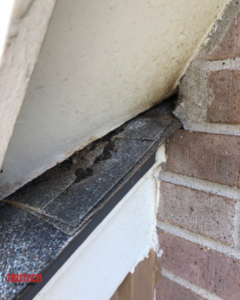
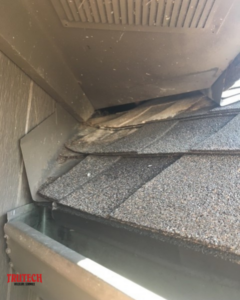
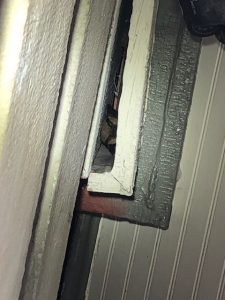
Signs of a Bat Infestation
You probably won’t see any actual bat in your home. You’ll notice a bat problem either from hearing bat noises or seeing signs like piles of guano, rub marks, or a strong scent of ammonia.
Bat Noises
Bats make sounds that are two or three times higher than humans can hear. When the flying mammals use echolocation, humans are only sometimes able to make out very quiet clicks. You might hear bats flying when they leave or return. As flying mammals, bats make fluttering noises with their wings. If you hear scratching that could result in bats climbing.
Bat Guano
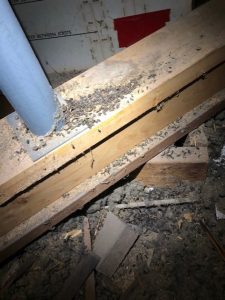
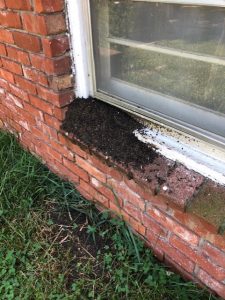
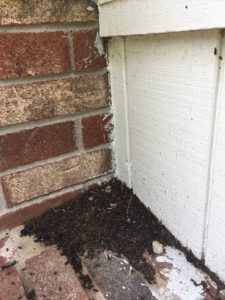
Bats defecate where they roost, and piles of guano (bat feces) will accumulate.
Bat guano has an pungent, musty, acrid aroma. It can stain walls and ceilings and weaken the structural integrity of your home.
If you suspect bats, be careful while investigating. It is extremely important for a respirator to be worn when in an attic containing bats. Histoplasmosis is a respiratory infection linked to bat guano. The fungus Histoplasma grows in guano and when disturbed it is possible to breathe in the airborne spores.
Smudge Marks
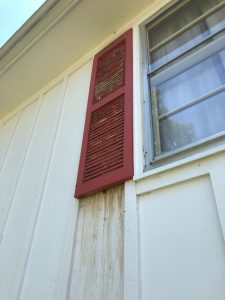
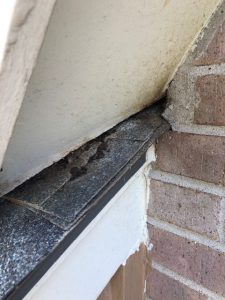
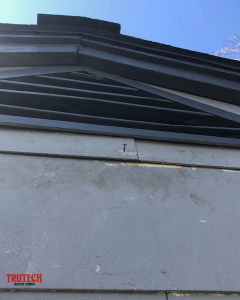
Marks on the side of your house can be a sign of bats. In the first picture, bats roosted in this home’s shutters. The smudges under the shutter are guano.
Because bats roost upside down, they are covered in their own feces. When bats squeeze into your home, they leave behind smudge or rub marks.
How to Get Rid of Bats
There are six species of bats that are federally protected. It is a federal violation to use chemicals including insecticides, rodenticides, disinfectants, and mothballs to kill bats. Most states have restrictions on when bats can be removed. Most states have further regulations on when bat removal should happen.
If a bat is in your living space, the top priority is to keep you as well as the bat safe. Bats should never be handled with bare hands. Our wildlife specialist will use gloves specifically designed to handle animals and ensure the bat is safely released outdoors.
Humane Bat Removal
The most effective and humane way to remove bats is by using a bat valve in conjunction with a full home exclusion. A bat valve allows for bats to exit your home but not re-enter.
Once the bat valve is installed, all other entry points will be sealed, allowing for bats to only exit through the valve. The removal process typically takes 3-7 days. Our specialist will perform a final attic inspection before removing the valve. After removing the valve, seal the final entry point.
Each bat removal is unique, so you need to create or use a bat valve specifically for your situation. Most of the time, you only need one bat valve.
Bat Control
Because some bat colonies return to the same roost year after year, it is important to prevent bats. Bat proofing your home is the only effective way to keep bats out. Bat repellents like mothballs or aluminum foil are not effective and might be hazardous or illegal.
Bat Exclusions
Bat exclusion is the most effective form of long-term bat control. Exclusions prevent bats from entering your home. Bats can squeeze into tiny holes so you need to seal all cracks, plug all holes, and use tight-fitting screens. Hardware cloth (1/4 inch or smaller), caulk, sealant, and weatherproof foam strips are excellent materials for excluding bats. It is tedious but important to locate every active and potential opening.
Bat Prevention
Because some bat colonies return to the same roost year after year, it is important to prevent bats. Bat proofing your home is the only effective way to keep bats out. Bat repellents like mothballs or aluminum foil are not effective and might be hazardous.
Professional Bat Removal
Getting rid of bats can be tricky for the untrained individual. There are federal and state regulations about how and when you can remove bats from your home. Without proper PPE, you can put your health at risk. Without proper experience and training, it is easy to overlook a bat entry point.
Special thanks to Alex Gray, Wildlife Removal Technician in Kansas City for sharing these photos.
Call to Schedule Free Bat Inspection
Bat Removal Near You

Bats in Jacksonville, FL
There are 13 species of bats in Florida; several of these, including little brown and big brown bats, may be found in residential homes and

Bats in Tampa-St Petersburg, FL
Florida is home to thirteen bats, and all of them eat insects. Residents in Tampa Bay can experience incredible benefits from bats on their property.
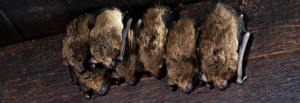
Bats in Orlando, FL
Bats are found in nearly every geographic region in Florida. Their favorite environments include tropical forests, woodlands and open fields. Natural roosting spots include caves,

Bats in Kansas City
Kansas is home to fifteen species of bats, and all of them are insectivores. Bats in Attic in Kansas City Bats in Kansas naturally roost
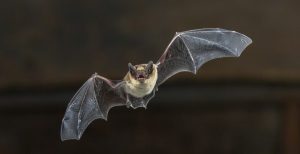
Bat Removal in Northeast Ohio
There are eleven species of bats commonly found in Ohio. The solitary species are the hoary bat, the silver-haired bat, and the Eastern red bat.
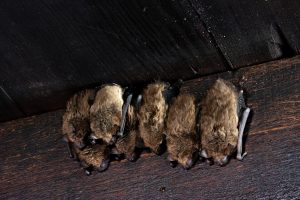
Bat Removal in Raleigh
The most humane way to get rid of bats is to let them evict themselves. A bat valve allows bats to fly out of your


